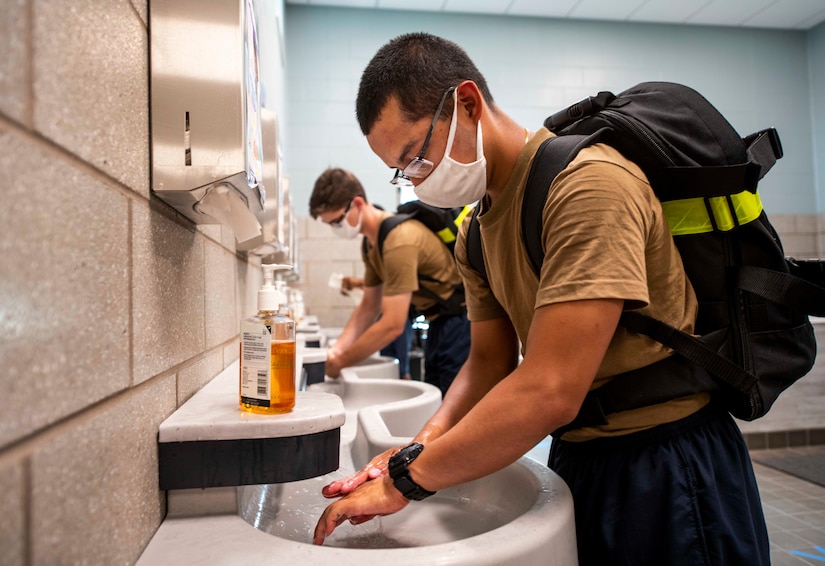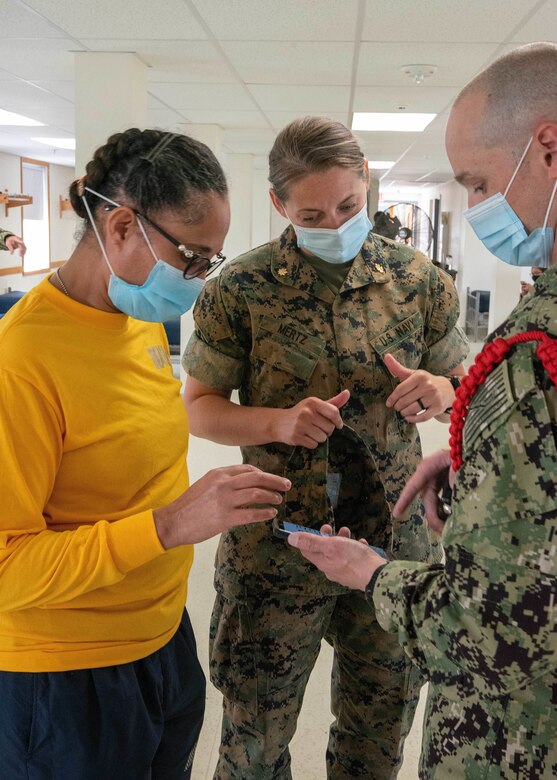Oct. 9, 2020 |
Since the onset of the coronavirus pandemic, the Navy has taken great care to protect its newest recruits from the virus, establishing precautions and measures that enabled the service to graduate more than 17,000 recruits through boot camp since March. To support this mission-essential undertaking, sailors from within the MyNavyHR enterprise volunteered to oversee and lead the establishment of the restriction of movement, or ROM, site for recruits at Fort McCoy, Wisconsin.
In August, 13 sailors from Commander, Navy Recruiting Command boarded a bus with 13 other sailors from various commands based out of Millington, Tennessee, and headed for Wisconsin. The all-volunteer crew of 26 sailors was mixed in rank spanning from E5 to E9, with their Navy experience being as diverse as their personalities.

''This is a one-of-a-kind mission," said Chief Petty Officer Justin West, a cryptologic technician (interpretive) assigned to Navy Recruiting Command. "Even though there was no previous blueprint to follow, the ability of sailors to come together and accomplish so much in such a short amount of time has been nothing short of awesome."
West alluded to the team's goal, which was to establish a ROM site for Navy recruits to be tested for the coronavirus and wait in a 14-day holding pattern at a safe environment to mitigate the risk of spreading the virus before being transported to Recruit Training Command in Great Lakes, Illinois.
"It's a testament to our Navy that sailors have come together so quickly and efficiently to produce something of this caliber," West said. "Everyone has shown an extremely high level of professionalism and motivation to draw from, and that has helped us tremendously."
The Millington team met up with RTC staff Sept. 14, and immediately began work on preparing open bay Army barracks for the weekly arrival of new recruits.
"The beginning was complicated as everyone showed up at Fort McCoy," said Navy Command Senior Chief Mark Rayner, RTC Fort McCoy ROM detachment senior enlisted leader. "Everyone pulled together, and after just two days, barracks were being set up, training sessions were being held and teams were being established ready to receive the first 600 recruits the following week. The individuals here really displayed the agility and grit that U.S. Navy sailors bring to the fight, and they weren't going to let this mission fail."
Establishing a ROM location at Fort McCoy, an Army training center in western Wisconsin, ensures the long-term safety and security of the recruits. It also consolidates support staff in one location while continuing to execute the essential task of training the Navy's newest sailors.
"The benefits of the Fort McCoy ROM site are endless," Rayner said. "We are able to operate a mission totally focused on restriction of movement, while independent from RTC's training mission. Our open bay barracks layout provides a perfect balance to be able to keep the ROM recruit population in small groups to reduce risk while allowing for around-the-clock active leadership and development from the recruit supervisors in the barracks."

Essentially, all inbound recruits receive the basics in rank recognition, general orders, the Sailor's Creed, RTC's chain of command and more. Each barracks is equipped with TVs and tablets where staff stream curriculum. Staff are able to get to the core of warrior toughness training and incorporate it into their daily routine.
Some of the boot camp survival skills start at the barracks where they learn how to live together in large groups. Other skills come from forming up in small groups to go to the base chow hall for each meal. In the end, leaders could see the two-week ROM period was preparing recruits for when they arrived for basic training at Great Lakes.
"Without a doubt, the recruits coming out of Fort McCoy will be better prepared with a foundation of basic military knowledge," Rayner said.
In July, CNRC increased shipping to an average of 1,200 recruits per week, while maintaining safety standards for the coronavirus. Consequentially, the Navy was the only military branch in fiscal year 2020 to make their active duty enlisted recruit-shipping goal. The Navy's eagerness to work with the Army to create a ROM site is an example of the creative problem solving needed to man the fleet.
"The entire Navy relies on this mission as we are the first stop for new recruits before moving on to the Navy's only boot camp," Rayner continued. "The fleet is in need of skilled junior sailors, and this mission has allowed the Navy to be the only branch to stay on track, reach the accession goal for the fiscal year, provide new sailors to the follow-on training and, in turn, add the needed support in the fleet. The Fort McCoy ROM mission reduces risk to force while maximizing throughput of new personnel through the training pipeline."
The requirement for support from Millington sailors ended after a month, as RTC brought in 135 staff to continue the ROM mission, and the 26 volunteers returned to Millington.
"We currently have 90 recruit barracks, 10 staff barracks, 11 admin and supply buildings and six classrooms," said Chief Petty Officer Jessica Barnes, assigned as the Fort McCoy operations chief for RTC.

"RTC and this team will make it so that we can sustain this operation forever if we had to. We are creating processes for longevity so that anyone who comes after us could pick up where we left off," Barnes said.
RTC continues to protect the welfare of its recruits and staff and works closely with medical experts to mitigate the transmission of the coronavirus.
"We train everyone in basic hygiene like handwashing, ensuring we train and enforce proper mask wear and social distancing. Our sanitation protocols are above recommended standards, and our entire operation is designed to minimize contact,'' Barnes said. "We also have a wonderful medical team, onsite, that has proven time and time again to find a way. They have helped us develop our barracks layouts, marching formations and how we balance the mission with training. The last benefit is having the capacity for our own isolation and quarantine barracks in case anyone does receive a positive test result."
Boot camp is approximately eight weeks, and all enlistees into the U.S. Navy begin their careers at the command. Training includes physical fitness, seamanship, firearms, firefighting and shipboard damage control along with lessons in Navy heritage and core values, teamwork and discipline. More than 40,000 recruits train annually at RTC.
(Navy Chief Petty Officer Elijah G. Leinaar is assigned to Navy Recruiting Command).








No comments:
Post a Comment